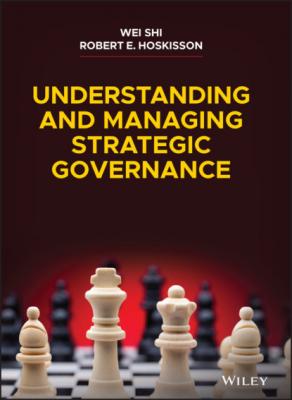ТОП просматриваемых книг сайта:
Understanding and Managing Strategic Governance. Wei Shi
Читать онлайн.Название Understanding and Managing Strategic Governance
Год выпуска 0
isbn 9781119798286
Автор произведения Wei Shi
Издательство John Wiley & Sons Limited
13 13. Sherman, E., & Eccles, R. G. (2007). KPMG(A): A near-death experience. Harvard Business School Cases.
14 14. Quigley, T. J., Hambrick, D. C., Misangyi, V. F., & Rizzi, G. A. (2019). CEO selection as risk-taking: A new vantage on the debate about the consequences of insiders versus outsiders. Strategic Management Journal 40(9): 1453–1470.
15 15. Sanders, W. G., & Hambrick, D. C. (2007). Swinging for the fences: The effects of CEO stock options on company risk-taking and performance. Academy of Management Journal 50(5): 1055–1078.
16 16. Kim, E. H., & Yao, L. (2018), Executive suite independence: Is it related to board independence? Management Science, 64, 1015–1033. Semadeni, M., & Krause, R. (2020). Innovation in the boardroom. Academy of Management Perspectives 34(2): 240–251.
17 17. Khanna, P., Jones, C. D., & Boivie, S. (2014). Director human capital, information processing demands, and board effectiveness, Journal of Management 40: 557–585.
18 18. Joseph, J., Ocasio, W., & McDonnell, M. (2014). The structural elaboration of board independence: Executive power, institutional logics, and the adoption of CEO-only board structures in US corporate governance, Academy of Management Journal 57: 1834–1858.
19 19. Baysinger, B., & Hoskisson, R. (1990). The composition of boards of directors and strategic control. Academy of Management Review 15: 72–87.
20 20. Zorn, M. L., Shropshire, C., Martin, J. A., Combs, J. G., & Ketchen, D. J. (2017). Home alone: The effects of lone-insider boards on CEO pay, financial misconduct, and firm performance. Strategic Management Journal 38(13): 2623–2646.
21 21. Power, M. (2000). The audit society–second thoughts. International Journal of Auditing 4(1): 111–119.
22 22. Fama, E. F., & Jensen, M. C. (1983). Separation of ownership and control, Journal of Law and Economics 26: 301–325.
23 23. Haynes, K. T., & Hillman, A. (2010). The effect of board capital and CEO power on strategic change. Strategic Management Journal 31(11): 1145–1163.
24 24. McNulty, T., & Pettigrew, A. (1999). Strategists on the board. Organization Studies 20(1): 47–74.
25 25. O'Kelley, J. R., Jones, A.-L., & Neal, P. 2019. Going for gold: The 2019 global board culture and director behaviors survey: Russell Reynolds Associates.
26 26. Pugliese, A., Bezemer, P.-J., Zattoni, A., Huse, M., van den Bosch, F. A. J., & Volberda, H. W. (2009). Boards of directors' contribution to strategy: A literature review and research agenda. Corporate Governance: An International Review 17(3): 292.
27 27. Finkelstein, S., Hambrick, D. C., Cannella, A. A. (2009). Strategic leadership: Theory and research on executives, top management teams, and boards. New York: Oxford University Press.
28 28. Krause, R. (2017). Being the CEO's boss: An examination of board chair orientations. Strategic Management Journal 38: 698.
29 29. Finkelstein S., & D'Aveni, R. A. (1994). CEO duality as a double-edged sword: how boards of directors balance entrenchment avoidance and unity of command. Academy of Management Journal 37(5): 1079–1108.
30 30. Sundaramurthy, C., & Lewis, M. (2003). Control and collaboration: Paradoxes of governance. Academy of Management Review 28(3): 397–415.
31 31. Withers, M. C., & Fitza, M. A. (2017). Do board chairs matter? The influence of board chairs on firm performance. Strategic Management Journal 38: 1343–1355.
32 32. Harrison, J. R. (1987). The strategic use of corporate board committees. California Management Review 30(1): 109–125.
33 33. Kolev, K. D., Wangrow, D. B., Barker, V. L., & Schepker, D. J. (2019). Board committees in corporate governance: A cross-disciplinary review and agenda for the future. Journal of Management Studies 56(6): 1138–1193.
34 34. Hillman, A. J., Shropshire, C., Certo, S. T., Dalton, D. R., & Dalton, C. M. (2011). What I like about you: A multilevel study of shareholder discontent with director monitoring. Organization Science 22(3): 675–687.
35 35. Withers, M. C., Hillman, A. J. & Cannella, A. A. Jr. (2012). A multidisciplinary review of the director selection literature. Journal of Management 38: 243–277.
36 36. Shi, W., Hoskisson, R. E., & Zhang, Y. A. (2017). Independent director death and CEO acquisitiveness: Build an empire or pursue a quiet life? Strategic Management Journal 38: 780–792.
37 37. Krause, R., Semadeni, M., & Cannella, A. A. Jr. (2013). External COO/presidents as expert directors: A new look at the service role of boards. Strategic Management Journal 34: 1628–1641.
38 38. Cumming, D., Leung, T. Y., & Rui, O. (2015). Gender diversity and securities fraud. Academy of Management Journal 58(5): 1572–1593.
39 39. Adams, R. B., & Ferreira, D. (2009). Women in the boardroom and their impact on governance and performance. Journal of Financial Economics 94(2): 291–309.
40 40. Nekhili, M., & Gatfaoui, H. (2013). Are demographic attributes and firm characteristics drivers of gender diversity? Investigating women's positions on French boards of directors. Journal of Business Ethics 118(2): 227–249.
41 41. Abdullah, S. N., Ismail, K. N. I. K., & Nachum, L. (2016). Does having women on boards create value? The impact of societal perceptions and corporate governance in emerging markets. Strategic Management Journal 37(3), 466–476. Post, C., & Byron, K. (2015). Women on boards and firm financial performance: A meta-analysis. Academy of Management Journal 58(5): 1546–1571.
42 42. Guldiken, O., Mallon, M. R., Fainshmidt, S., Judge, W. Q., & Clark, C. E. (2019). Beyond tokenism: How strategic

